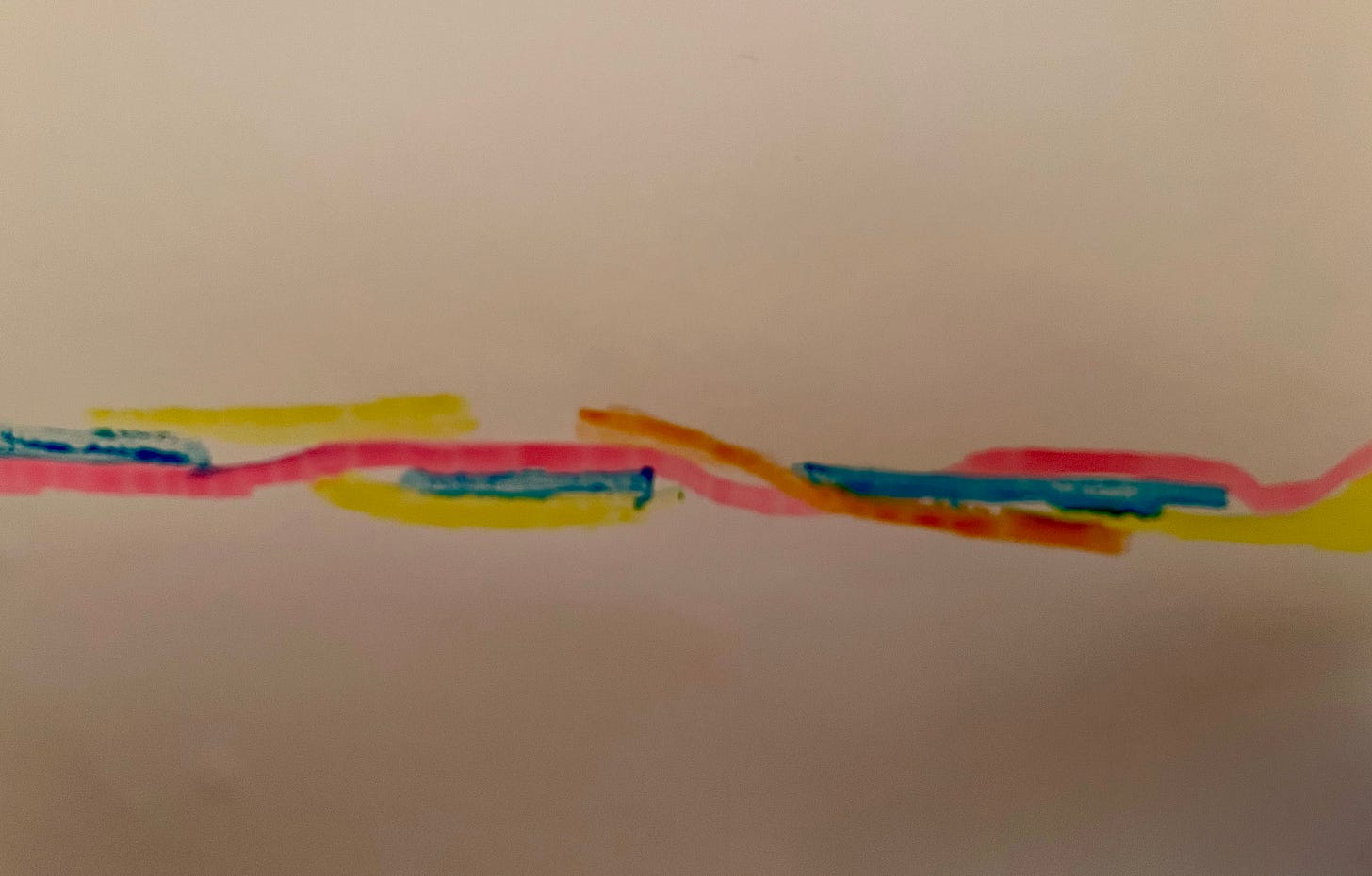
Stories are written as they come. And how they come is often not linear.
John Irving claims to write his closing sentence first, and then to gestate the whole for months before he begins again... from the beginning.
Other writers might write the scene of climax and work their way backwards.
Some write scenes beginning with whatever first comes to their mind, and continuing in the same manner, ending up with a complete chapter here, a partial scene from there, and snippets.
We’ve heard the stories—or we even work that way—of papers scattered all over the room, and trying to assemble them into some shape. Rearranging, and back again.
These stories generally do include the word “paper,” which says something about working on screen vs. working on dead tree.
There are stories too, of organizing 3X5 cards, or sticking post-its to the wall. But those stories are about outlining.
This post will look at what happens when you have what feels to be a full first draft, albeit in pieces, and you’re asking:
Now what?
Some books emerge in this way. At the time, it feels organic. You may have even fought it as it came, tried to wrestle it into some recognizable shape. If you’ve written a novel before now and that first one appeared in a more stream-lined way, then the process with “pieces” can feel unsettling.
Or perhaps this is your first try at a full-length work.
For the purposes of this post, let’s say we’re talking about works of more than a hundred pages, more than a novella, more likely more than 200 pages—a full-length novel.
Whether it’s your first novel, or your tenth—but it’s oh so different than your others—this messy piecey stuff is its own process.
I’ve worked with both, and the shadings in between. With a linear write, it seems there are always some pieces that pop up out of nowhere. Or some you know must be moved to some other place in the chronology. The chronology of a novel is frequently not A-to-Z.
Even when I’ve written in a linear way, there have always been days where I’m stuck, and the only way forward is to abandon the blocked scene, and move on to whatever comes next. I’ve found that the busier my non-writing world is, the more likely I am to fall into writing in pieces. It feels as if multi-tasking spills over into my work.
Or if I get recurring instances of “block” and keep leaping over, then more and more the thing comes out in bits.
When it’s working
I suspect some books/stories are meant to be in pieces. There’s no reason to assume something is not working, just because it looks unusual.
The question that we always deal with: does it serve the story?
Is there a reason—usually concerned with the content—that explains why this form is the perfect vessel to carry it?
My memoir, for instance, ended up as a hybrid of free verse and prose, all in rather short bites, with titles and numbers on each. Altogether, they created the much-needed white space for some heavy material. The “bites” work towards either a quick read—which is how some readers approached it—or its opposite: a read of setting the book down, and picking it up again, as one was ready. The subject matter was weighty; I wanted the pages to appear lightened.
Can you see how this might work for your story?
Or it might be a novel that is really a collection of connected short fictions. The pieces might each build upon the others, without needed to be “threaded through.” Is this the case? (Can you see it? Does your writing group or writing-partner reflect this back to you?)
A couple weeks ago I posted about “general and specific” time; be aware of when you’re writing in “general.” If a lot of “general” time is showing up in this collection of discrete pieces, it may be that you are writing back-story and material in which the story is summarized.
Does this sound a lot like “Show-don’t-tell”? They have commonalities, yes.
(These two show/tell posts are from last January.)
and:
The reason the bits and pieces of my memoir function as a “whole” is because each section—with some few exceptions * which I’ll speak to—is very specific in looking at a brief bit of time, a short scene, introducing a person or motif, a struggle with some metaphor, and more. For each piece, I can articulate it as: this is about _________, and the blank will be filled with a brief phrase.
“Brief” is the operative word and strategy. Weeks and months are not summed up within any one bite. With the exceptions noted below—
*NOTE: there are a very small number of sections in which I DO cover time, in which I’ll pull out one single thread that runs throughout the chronological time of the memoir (almost one full calendar year), and focus on that one thread within that section.
There’s a patterning to this, a design.
By having such single-scene/focused sections, interspersed with a minimal number of pieces that create the through-threads, it functions together as a whole.
If I were to diagram a work like this, it might look something like this:
The pink line weave through the whole! Even the most “in pieces” story often some sort of through-line. In this diagram, there’s a point at which the orange and blue story-threads seem to obliterate the pink. Yellow pops up; blue is in patches.
Creating such diagrams can help to visualize the cohesion and shape you want. Every story of length needs cohesion and shape—of some sort. Can you diagram yours? Does the diagram reveal holes and overlaps? Places/ideas/story info/characters that need thinning or thickening?
Note any “gut” responses on your diagram, even if you can’t articulate what it might mean; gut responses, in re-reading as writer—need to be acknowledged. At some point. I’ve often had one, that later is verified by a beta-reader, or I ponder and try to articulate what is not working, and make discoveries as I do.
And do mark out all that is working. I have colour-coded the font of entire manuscripts with red to signify “re-write,” and green for “what’s working—don’t touch!” and blue for “re-visit this!” and other colours for various reasons as the manuscript needs.
And when it’s not working
When you’re surrounded by those papers laid out all over the room, or you click open a file, only to feel overwhelmed by a sense of the maze of it all. and you wonder: what to do with all the pieces?
Let’s do this in steps. You can choose the steps that work for you, and skip others. Also, let me know if I’ve missed one that worked for you, or you feel might for others.
Possible steps
—review each piece with a view to the “general and specific” senses of time. Mark these, and /or
—make a note on each piece about the passing of time: is the piece a cohesive and single scene/moment? Or is it one of those “long-thread-moving-throughout” pieces? Is it a bit of a muddle that includes both single scene and long thread elements? Should you make a note to separate these two at some point?
—if you create a list (vertical) can you see any patterning to the types of pieces? Or create a diagram (horizontal) for this purpose. Or some marriage of these two, that works for you to understand and be able to envision as a whole. Note that getting to the point, in the writing of a novel, to FEEL/experience/see it as a “whole” is key to creating a full-length work; it’s when you know you’re done or close to.
—think of the work proportionately. You might want to create another diagram devoted to this exploration. There’s a makeshift practicality to this, I must say! For instance, in my current re-write, my novel is divided into 4 sections in addition to chapter breaks.
The first section is supposed to be “introductory.” My sense is that it should be about 1/3 of the novel (for various reasons I won’t go into here.) But it is 130+ pages of 330 pages. I need to cut 20 pages.
Yes, numbers can be arbitrary things—the bane of us word folks, really. But knowing “20” is the number gives me a green-light to feel okay about wielding—even running with—the scissors! It’s so easy to get caught up in convincing ourselves “that has to stay.” When I instead begin to think “20” (or whatever it is), I suddenly begin to see entire paragraphs differently. Even chapters. Does the story really need this? Becomes the question.
—number chapters onto sheets of paper. Estimate—operative word!—how many you might need. If you’re writing in short pieces that you’ve left un-numbered to this point, you might begin to see how they’ll fit within sections according to some story logic you can come up with. Say, a small number of these pieces that “fit” within a time or place or the turns of plot.
On each of these sheets of paper—one for each “chapter”—jot notes about what happens in this chapter. For those discrete pieces—short scenes, defined time— a few hours, a day or two—that can work within one space, this is easy. It’s those pieces that include longer times passing, or the evolution of a thread over time. For those pieces, break down the story line, and note some in each chapter in which it might show up.
Knitting
Let’s spend more time on this concept, and come up with an example.
In keeping with the post, let’s say your character stumbles over “knitting.” Here’s a guy who’s never come close to needles and yarn in his life. Except he remembers his veteran-grandfather knitting—something he learned in training, and found comfort in doing.
Let’s say you were writing a scene, nothing to do with “knitting” and out of nowhere—it seems—your character developed a yen to do this. Maybe he’s cleaning out his mother’s home—she’s going into care, and his sister starts to throw out a basket of knitting supplies, and something tells him to grab the basket, throw it in his car, rescue it from the enthusiastically-tossing sibling.
In the remainder of this scene, you’ve now included the entire trajectory of this piece. What can we say: you got excited and went with the initial push to explore this funny little idea. And now you have what appears to be a wonderful and evocative analogy/metaphor of knitting in this character’s life. Except you have it ALL within the one scene.
So to pull it as a thread throughout, you take this initial piece—his discovering the basket, and you decide this is going to show up in the fourth chapter of the whole. So you jot this onto the paper (real or virtual) for that chapter.
Then, in the way that life happens, the character—let’s name him Hal after a guy I used to work with who did indeed take up knitting when he was in his thirties and decided that sweaters were far too expensive… (I digress… but he did.) He’d sit in the staff room between hairdressing clients and knit. He made beautiful things, and wore them, so pleased.
So Hal forgets about the basket tossed in his car, and in chapter seven he has a dreadful day, when everything falls to pieces, and someone breaks into his car, pulls out things of value…but leaves the basket on the sidewalk beside the car. Hal picks it up. Takes it into his home, sits staring at it. That’s all you need for that chapter… Hal’s life goes on.
Several chapters later, the reader needs to see that Hal is attempting to wrest back control of his life, and we see him awakening in the middle of the night, unable to sleep. He gets up, heats milk to calm his stomach, sees the basket, the needles the green yarn… and he finds a youtube video on how to do this thing. As he watches the video he remembers his grandfather’s hands knitting. He is strangely calmed, and wonders at it.
His life continues to fall apart through the next half dozen chapters, but in bits and pieces, Hal continues to learn and to knit and to create a scarf. You jot notes into each chapter “page” to follow the progression of this throughout the story. You might ignore—for now—what the rest of each of those chapters is about. (Though if you’ve already made such notes about other elements of the story, do read and see how and where this—the knitting thread—will best sit.)
So much can happen. A partner in a nasty mood might pull out a needle! A child might unravel! Or perhaps this knitting piece is the one and only part of Hal’s life that is actually smooth. (Because we all need some breathing space.)
Does Hal have some epiphany or minor insight as he completes the scarf? Say in chapter nineteen? Just before he tackles what he needs to say to someone? How is the metaphor of “knitting” (together?) going to work?
What is the last moment that the reader will see of that scarf? Will Hal be wearing it? Has he given it away? Will it culminate in some moment of horror, Isadora Duncan-esque?
Of course, as you actually write the story, organizing and weaving through the chapters, there might be great shift from the original plan.
But this work will give you some sense of pacing with which to work. This plan will take one of those pieces, and stretch it, weave it through.
That’s a lengthy example for one point of how to s-t-r-e-t-c-h out a story-thread. But I hope it makes sense.
Back to the general approach list:
—there may be other scenes, that you have not yet written, but as you work to develop the plot and pacing, you know they’ll be needed for the whole. If you have such scenes in your head, and you’re not sure where else to go in all this organizing, just write them! When “stuck,” write the next piece that comes to mind. If nothing else, even if you’re not sure just where yet another piece will go, you’ll be back to the writing.
And add this new piece into the mix, into the sorting of chapters.
—once you’ve done this noting and jotting of ideas through these pages of chapters, your discrete pieces should have a feel of how they will work together, expanded as needed, and functioning with more of a sense of cause/effect.
Warning! It may still feel to be a Mess.
That’s okay.
It can be a number of drafts before it feels otherwise. There’s nothing tidy about writing.
But for now, this is a big step: from a collection of pieces to knitting together…






Alison, your timing is excellent. I have been looking with dismay at the tangled web of a murder mystery I've sorta kinda maybe? got in first draft. It's there. I can feel it. Just needs some bridges connecting pieces and to be put in the right order . . .
Actually, I've been panicking and avoiding, but your piece today helped. Thanks.
Hey, how do you eat an elephant?
One bite at a time.
Going to take a bite now.
Wow, Alison, completely appreciate this. I have finished my novel and hope to do a very absolutely final read over the holidays. (It has been sitting for a few months.) I really feel good about it, but what you have suggested and the knitting example, all of a sudden objects and scenes present themselves like pieces of a puzzle that I could easily and effectively drop into the story, which would help to work subtly on my reader's mind (I think/ hope/ believe) to continue to achieve/ reinforce what I believe the story is about. I'm going to sit with this for the next few weeks, before I work on it and see what comes up, things are already starting to bubble to the surface. I'm very excited! Thank you.